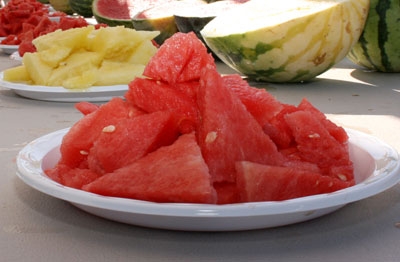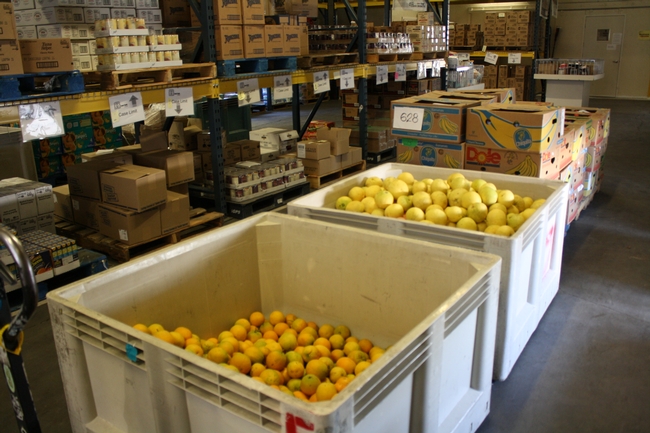Posts Tagged: fruits
Some hae meat, and canna eat . . .
"Some hae meat, and canna eat,
And some wad eat that want it . . ."
The words are old and a little hard to understand, but they tell a story that's as true today as when the poet Robert Burns spoke them back in the 1790s. They were old words even then. Always, it seems, there are those of us who are fortunate enough to eat well and those of us who go hungry, even in a country as rich as ours.
One morning last May, I got to meet some folks who help ease that hunger in the community where I live. That morning I drove with my wife to an industrial area on the northeast side of Woodland, California, where the Food Bank of Yolo County does its business. Outside the warehouse door delivery trucks from local markets, chain stores, farms, and other food sources came and went, mingling with buyers' pickups and trailers from churches and other charitable groups.
The big trucks were there to deliver what many retailers would consider marginal goods: bread, dairy products, meats, and canned and dry goods that were moving too slowly off the shelves or getting too close to their sell-by dates; a cardboard harvest bin of loose carrots in the walk-in, donated by a grower who was getting ready to put in a new crop; 50-pound sacks of potatoes or onions that were either too much for the food service market or were set aside by generous handlers or a government agency for exactly the purpose they were about to serve: to feed the hungry.
These days about 35 percent of the stock you can see in this Food Bank warehouse has been donated outright. The rest comes from government agencies or direct purchases from the California Association of Food Banks. A few years ago the directors of the Food Bank of Yolo County shifted their focus toward providing clients with fresher, more nutritious food, and since then they have brought their fresh produce sales from about 50,000 pounds a year up to a high of 1 million pounds in 2010.
That morning in May my wife and I joined other groups of buyers inside the warehouse, each of us picking through the low-priced goods for just the right mix of products to refill the shelves of a soup kitchen or—as in our case—a local food closet. Loaves of bread, a case of canned tomatoes, a box of apples, macaroni and cheese mix, a shrink-wrapped bundle of bags of flour. We loaded our wheeled dolly three times: first came the bread, which a food bank volunteer weighed before we loaded it into the truck; then the produce, likewise weighed on the dolly and loaded; and finally the canned and dry goods, which are priced by the case. Five flats of eggs we put in the pickup's back seat for a smooth ride. For a little less than $100 we got enough food to fill the truck.
A short trip then took us back to the food closet at our church, where 8 or 10 women and men, most of them well into their retirement years, bustled around the edges of the sorting table that filled the middle of the small room, stacking cans on shelves, putting bread, tortillas, and eggs into the refrigerators, doling potatoes, onions, rice, and beans from 50-pound sacks into smaller, consumer-sized bags, and pointing out to me firmly and kindly each time I put a box or bag down in the wrong place. Which was pretty often. Before an hour was up, the closet was stocked and locked up and ready for food distribution the next day. Two distributions a week from our closet alone can serve up to 50 families in need.
There's plenty that you can do, too, to help relieve hunger in your own community. Find your nearest food bank on the California Association of Food Banks website, or ask around to find out about local food closets or soup kitchens.
Then all you need to do is pitch in. If you've got the time, they've got the need.
Eating right doesn’t have to break the budget
Even though dietitians have for decades strongly recommended eating lots of fruit and vegetables daily, very few Americans hit the mark. Food prices, taste, inconvenience, and a failure to understand the link between diet and health have been blamed for Americans’ poor food choices.
New research by the USDA Economic Research Service dispels one of those obstacles. The study determined that buying the recommended amount of fruits and vegetables costs on average only $2 to $2.50 per day.
“For those with access and the means to buy them, the assertion that fruits and vegetables are too expensive is not a good excuse,” said UC Cooperative Extension nutrition, family and consumer sciences advisor Cathi Lamp. “Consumers should be able to purchase a days’ worth of fruit and vegetables for less than it costs to buy a cheeseburger.”
The ERA researchers estimated the average retail prices of 153 fresh and processed fruits and vegetables. Processed fruits and vegetables included frozen, canned and dried plus 100 percent fruit juice. They also estimated the average price per edible cup for each vegetable and fruit.
Costs in the study were defined as the average prices paid by all American households for a food over a one-year period, including purchases in different package sizes, under different brand names and at different types of retail outlets (including supercenters such as Wal-Mart, wholesale club stores like Costco, traditional grocery stores such as Safeway, Kroger and Albertsons, and convenience stores.)
The research indicated that:
- Fruits and vegetables cost about 50 cents per edible cup.
- The lowest average price for any of the 59 fruits in the study was for fresh watermelon, at 17 cents per cup. The highest average price was for fresh raspberries, at $2.06 per cup.
- Among the 95 fresh and processed vegetables in the study, a cup of dry pinto beans was the least expensive at 13 cents. The most expensive was frozen asparagus cuts and tips at $2.07 per cup.
- Processed fruits and vegetables were not consistently more or less expensive than fresh produce, but with certain types of produce, the prices varied quite a bit. Canned carrots, at 34 cents per cup, were more expensive than fresh carrots, at 25 cents per cup. However, canned peaches, at 58 cents per cup, were less expensive than fresh, at 66 cents per cup.
Lamp suggested smart shopping can also help consumers reduce the cost of their fruits and vegetables. For example, buy fresh fruit and vegetables in season, use canned and frozen fruit and vegetables when it is cheaper and stock up when items are on sale or when shopping at a supercenter or wholesale club.

USDA says fresh watermelon is, on average, the least expensive fruit.


